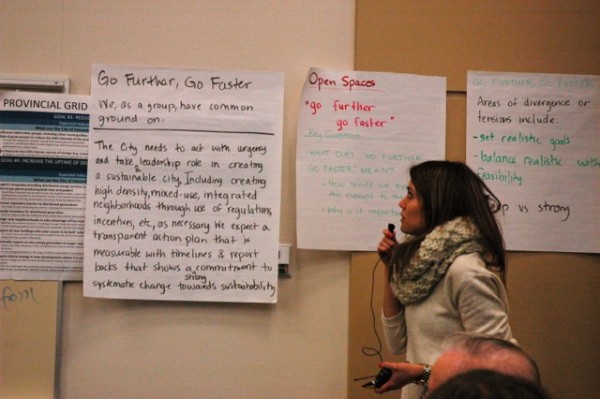Earth Hour Tour: Citizen Participation is the Key
On March 7, 2014 WWF’s David Miller moderated a panel discussion with a variety of experts, hosted by the City of Edmonton, Canada’s 2014 Earth Hour City Capital, and the University of Alberta. The topic: visions for a future where climate change is no longer a threat. We know that future is possible, and that the solutions are all around us – including in Edmonton. And we want all of Canada to learn from their successes. We asked panelists to answer a critical question: what is the one thing we need to do today to achieve that vision? Here is one of the answers we received.
Written by David Kahane, Professor of Political Science at the University of Alberta and Project Director of Alberta Climate Dialogue

Citizen involvement is crucial if governments are to respond skillfully to complex challenges like climate disruption and energy transition. In Alberta, where I live, governments already do a whole lot of public involvement—but this typically comes late in the development of policy, and is about testing or tweaking plans developed by civil servants and consultants. We need deeper forms of participation than this:
- Our climate responses are driven by values—for example, how we weigh our own welfare against that of future generations; what we think is most important in our lives; and how considerations of justice and equity play into our priorities. Bringing diverse citizens together to deliberate about values provides crucial guidance to governments.
- Government decisions often are steered or constrained by powerful economic stakeholders—for example, industries that profit from urban sprawl, or whose business models center on burning fossil fuels. Strong citizen involvement can provide a counterweight to political pressure from powerful interests.
- Some forms of citizen involvement—especially when extended over time, connected to civic organizations, and surrounded by strong publicity—can build community understanding, collaboration, and capacity for action on issues like climate change and community resiliency.
The organization that I lead, Alberta Climate Dialogue (ABCD), worked with the City of Edmonton and the Centre for Public Involvement to hold a 2012 Citizen Panel on Edmonton’s Energy and Climate Challenges. Fifty-six demographically representative and attitudinally diverse citizens spent six days deliberating and voting on recommendations. They said that the City should take the measures needed to become a low carbon city by 2050, and offered detailed guidance. The City, they said, should lobby to green the provincial grid; increase the proportion of development in compact, mixed- used, transit-oriented neighborhoods in already developed areas of the city; increase the energy efficiency of new and old buildings; and more. Seventy-one percent of participants went on to urge speed, saying that the City should “set strong, measurable targets for energy transition in a five-year time frame. In other words, it is important not just that the City seek ambitious changes in energy use by 2050, but that there be aggressive short-term targets so that transition begins quickly.”
We’re still waiting to see how Citizens’ Panel recommendations are translated into action by the City of Edmonton. But this exercise points to how governments can build wise and sustainable climate responses by bringing citizen voice to the center of decision making. There are dozens of great models of citizen involvement out there for governments that value collaborative decision making.
Just as crucial are forms of citizen participation that come from the grassroots up.
Edmontonians are already involved in GHG mitigation, energy transition, and resilience building in their communities through urban agriculture and local food movements, sustainable entrepreneurship in a revived urban core, collectives around bike culture, and in hundreds of other ways. They’re creating sustainable alternatives on the ground, and sometimes have to push the City for room to do this (the City’s reluctance to allow urban chickens is a bone of contention right now, for example). These alternatives—and the passionate citizens who craft them—draw other Edmontonians into sustainable behaviors not out of environmental guilt but because they want fulfilling relationships, stronger community, and a better quality of life. These on-the-ground alternatives show governments that there are strong and growing constituencies wanting change.
If we take the science seriously, creating a world in which climate disruption is no longer a threat will require not just technological innovation and entrepreneurship, but deep and quick transformation, including in our understanding of what it means to live a good life. As governments deepen their involvement of citizens in decision making and as citizens claim spaces for more sustainable and local ways of living, our conceptions of human flourishing also shift. As we slow down to encounter one another as citizens, wrestle together with political decisions, and build things together close to home, we uncover more human and fulfilling ways of being together. It’s from this deeper place that we can find our way to the climate solutions our world so badly needs.
Interested in participating in the Earth Hour Tour: Out of the Dark, Into the Future? We’re coming to Halifax on Friday, March 21 and Toronto on Tuesday, March 25.
Celebrate Earth Hour, 8:30-9:30 p.m. on March 29, and let us know what you’ll be thinking about during your #momentofdarkness at wwfcastg.wwf.ca/earthhour
